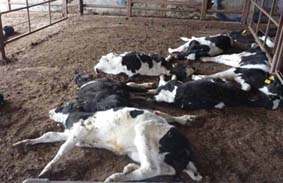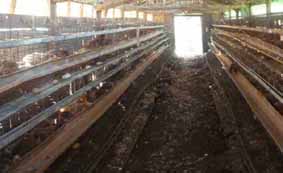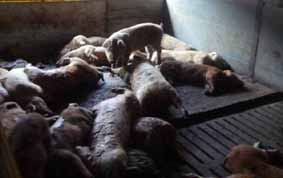| Great
Eastern Japan Earthquake & Tsunami/Fukushima Nuclear Power
Plant Accident |
The Fate of Animals in the Disaster Area
ALIVE NEWS May 1, 2011
Fusako Nogami (Director of ALIVE)
All of us at ALIVE send our deepest condolences and commiserations
to the victims of the unprecedented tsunami and earthquake. We also
extend our heartfelt sympathy to those who have been evacuated from
the areas around the Fukushima Daiichi Nuclear Power Plant. It will
take some time to recover from the damage caused by the natural
disaster and the subsequent nuclear power plant accident. I personally
feel great compassion for the many people who have been badly affected
by these calamities.
Livestock and companion animals are also among the victims of the
Great Eastern Japan Earthquake. Approximately one million head of
livestock are thought to have died due to the tsunami. Also, many
livestock animals that survived the initial disaster are now dying
of hunger or thirst, because electricity, water and public transportation
systems are not working, their owners have abandoned them, and nobody
is taking care of them. In this article, I am going to write about
the animals in the disaster areas that are facing this terrible
reality.
Dead livestock:
The Miyazaki Prefecture homepage has the following damage data.
(April 4, 2011)
· Damaged cattle sheds/barns and other facilities: 67; the
cost of damage is estimated at 1,000,000,000 yen.
· Dairy cattle, beef cattle, pigs, laying chickens and broilers
drowned or starved to death: 958,071; estimated damage 500,000,000
yen.
· Estimated cost of losses caused by milk contamination and
bans of sale of milk: 700,000,000 yen.
A similar scale of damage will be reported in Iwate, Fukushima and
Ibaraki Prefectures and I assume that the actual numbers for these
prefectures will be two to three times greater than in the case
of Miyagi Prefecture.
Non-functioning feed supplies:
Japan calculates its food self-sufficiency rate using calorie-based
numbers, although many consumers are unaware of this. The self-sufficiency
rate for livestock feed is very low. In fact, Japan imports 90%
of the grain used for livestock feed and it is estimated that about
25% of all livestock feed in Japan is imported. Corn (maize) is
the main cereal used for livestock forage and Japan imports 12 million
tons of corn every year. This is significantly greater than the
scale of domestic production of Japan’s principal cereal crop,
rice, which currently stands at 8 million tons per year.
The important ports in eastern Japan for livestock feed imports
are Hachinohe, Kamaishi, Ishimaki and Kashima. These ports are equipped
with huge storage tanks and mixing plants, but access to most of
the ports and facilities there has been hampered by the earthquake
and tsunami. The coastal navigation routes have also been destroyed,
so that large size ships cannot presently enter these ports. This
has caused disruptions to livestock feed supplies in the Kanto and
Koshinetsu regions and supplies have been halted in some areas.
In addition to the problems with feed imports, the land transportation
infrastructure has been crippled because of fuel shortages and damaged
roads, and as a result, livestock is dying of starvation.
¦The tragedy of dairy cattle farms:
 Large
livestock farms have been greatly impacted by electricity and water
shortages following the disaster. Holstein cattle require large
amounts of water and produce large amounts of milk, so lack of water
can be fatal. Most dairy farms separate calves from their mothers
as soon as they are born and the mother’s milk is taken for
human consumption. Milking is usually performed using a milking
machine or “milker”. A milker is powered by electricity
and it can’t function if electrical power is unavailable.
Milking is a very important process for dairy cows, because it prevents
mammitis, which is the third biggest cause of death in dairy cattle.
The power shortage problem is also affecting livestock directly.
Milk from the areas close to the Fukushima Daiichi Nuclear Plant
has been found to contain radioactive contamination at above the
maximum regulated level. Such contaminated milk is discarded. The
contamination has occurred because the dairy cattle have drunk radioactive
water. Large
livestock farms have been greatly impacted by electricity and water
shortages following the disaster. Holstein cattle require large
amounts of water and produce large amounts of milk, so lack of water
can be fatal. Most dairy farms separate calves from their mothers
as soon as they are born and the mother’s milk is taken for
human consumption. Milking is usually performed using a milking
machine or “milker”. A milker is powered by electricity
and it can’t function if electrical power is unavailable.
Milking is a very important process for dairy cows, because it prevents
mammitis, which is the third biggest cause of death in dairy cattle.
The power shortage problem is also affecting livestock directly.
Milk from the areas close to the Fukushima Daiichi Nuclear Plant
has been found to contain radioactive contamination at above the
maximum regulated level. Such contaminated milk is discarded. The
contamination has occurred because the dairy cattle have drunk radioactive
water.
The tragedy of large-scale poultry farms:
 In
terms of the number of individual animals killed, the biggest victims
of the current disaster have been laying hens. In Japan it is common
for an egg farmer or a farming company to keep between 10.000 and
100.000 hens. Poultry houses are usually windowless and the cage
floor space per hen may be as small as a sheet of B5 size paper.
Confined in such a restricted space, naturally, the hens cannot
easily turn or move around. The cages are placed one above another
in stacks between five and sometimes eight layers high. When the
earthquake hit, many of the cages were warped and destroyed, and
numerous hens were crushed to death. In
terms of the number of individual animals killed, the biggest victims
of the current disaster have been laying hens. In Japan it is common
for an egg farmer or a farming company to keep between 10.000 and
100.000 hens. Poultry houses are usually windowless and the cage
floor space per hen may be as small as a sheet of B5 size paper.
Confined in such a restricted space, naturally, the hens cannot
easily turn or move around. The cages are placed one above another
in stacks between five and sometimes eight layers high. When the
earthquake hit, many of the cages were warped and destroyed, and
numerous hens were crushed to death.
When these farms lost electrical power, the hens were left without
ventilation in confined areas and so they suffered from ammonia
toxicity. Water supplies were also interrupted, as a result of which
the water systems at many poultry farms malfunctioned and the hens
died of thirst.
These livestock were totally abandoned and forced to wait for death.
The utter cruelty of the immense pain they must have gone through
is unimaginable.
The tragedy of large-scale pig farms:
 The
workers and staff at pig farms near the Fukushima plant were evacuated.
The pig farm buildings or facilities did not sustain damage, but
abandoned pigs confined in their stalls without human care or help
could not escape from suffering and death due to hunger and/or thirst.
These animals being omnivorous, in many cases weakened and starving
pigs began eating each other and they were forced to suffer and
die under horrific conditions. The
workers and staff at pig farms near the Fukushima plant were evacuated.
The pig farm buildings or facilities did not sustain damage, but
abandoned pigs confined in their stalls without human care or help
could not escape from suffering and death due to hunger and/or thirst.
These animals being omnivorous, in many cases weakened and starving
pigs began eating each other and they were forced to suffer and
die under horrific conditions.
(photo:S. Imamoto)
The tragedy of laboratory animals:
Laboratory animals that live in confined conditions are also greatly
affected when lifeline supplies are cut off. Without food and water
they will quickly face death. Experimental facilities keep all sorts
of genetically modified animals and handle a wide variety of pathogens.
They also include toxic and radiation experiment facilities. If
these facilities are damaged, the effects can be immeasurable.
A major worry is that there is no registration or application system
for facilities engaging in animal experimentation and there is no
way legal way to trace down or oversee what goes on in these animal
experimental facilities. This is the reason why we cannot even know
the numbers of deaths of animals in laboratories. The recent earthquake,
tsunami and nuclear power plant disaster has revealed the urgent
need for legislative measures that will make public the locations
of animal experimental facilities as well as other detailed information
such as on the numbers of animals kept at each facility.
The tragedy of aquariums and zoos:
Large carnivores such as tigers and lions are kept at zoos. If the
zoos are damaged, there is an increased risk of these dangerous
animals escaping and this would create a huge commotion. Fortunately,
no zoos were damaged by the recent earthquake and tsunami, but a
large aquarium located on the shore of Pacific Ocean was badly damaged.
The electrical system at the aquarium was crippled, so the water
circulatory system in the exhibition tanks did not function. As
a result, more than 200,000 fish died.
¦ Biodiversity was damaged:
The unprecedented tsunami destroyed numerous houses, cars and other
household items and created a huge amount of debris. Noxious industrial
waste and toxic chemical materials continue to flow into the ocean
and are polluting the soil and water. Soon disinfectant solutions
will be widely applied in order to prevent epidemics, which may
cause further chemical pollution in the disaster area. Additionally,
a large amount of radiation has been released from the crippled
nuclear power plant and is contaminating rivers and soils. The contamination
levels of some farm produce are too high for it to be sent out for
public consumption, so shipments have been halted.
Highly radioactive water has been discharged into ocean, which is
in turn contaminating seaweed and fish. The nuclear power plant
accident has been prolonged and the agriculture and fisheries industries
in the vicinity have been suffering greatly. Radioactive materials
will be consumed by zooplankton and phytoplankton in the ocean,
and then fish and other marine creatures will eat the plankton.
In this way, highly toxic radioactive materials in the seawater
will become more concentrated in creatures that eat contaminated
plankton (biological concentration.) The toxic materials will be
passed on in food chain and may damage the DNA of various living
organisms. The process will take time but this invisible damage
in ecosystem will eventually have a malign influence on humans and
other animals. The time has come for all of us to fundamentally
rethink our current lifestyle that is so dependent on using electricity.
|




![]()
 Large
livestock farms have been greatly impacted by electricity and water
shortages following the disaster. Holstein cattle require large
amounts of water and produce large amounts of milk, so lack of water
can be fatal. Most dairy farms separate calves from their mothers
as soon as they are born and the mother’s milk is taken for
human consumption. Milking is usually performed using a milking
machine or “milker”. A milker is powered by electricity
and it can’t function if electrical power is unavailable.
Milking is a very important process for dairy cows, because it prevents
mammitis, which is the third biggest cause of death in dairy cattle.
The power shortage problem is also affecting livestock directly.
Milk from the areas close to the Fukushima Daiichi Nuclear Plant
has been found to contain radioactive contamination at above the
maximum regulated level. Such contaminated milk is discarded. The
contamination has occurred because the dairy cattle have drunk radioactive
water.
Large
livestock farms have been greatly impacted by electricity and water
shortages following the disaster. Holstein cattle require large
amounts of water and produce large amounts of milk, so lack of water
can be fatal. Most dairy farms separate calves from their mothers
as soon as they are born and the mother’s milk is taken for
human consumption. Milking is usually performed using a milking
machine or “milker”. A milker is powered by electricity
and it can’t function if electrical power is unavailable.
Milking is a very important process for dairy cows, because it prevents
mammitis, which is the third biggest cause of death in dairy cattle.
The power shortage problem is also affecting livestock directly.
Milk from the areas close to the Fukushima Daiichi Nuclear Plant
has been found to contain radioactive contamination at above the
maximum regulated level. Such contaminated milk is discarded. The
contamination has occurred because the dairy cattle have drunk radioactive
water. In
terms of the number of individual animals killed, the biggest victims
of the current disaster have been laying hens. In Japan it is common
for an egg farmer or a farming company to keep between 10.000 and
100.000 hens. Poultry houses are usually windowless and the cage
floor space per hen may be as small as a sheet of B5 size paper.
Confined in such a restricted space, naturally, the hens cannot
easily turn or move around. The cages are placed one above another
in stacks between five and sometimes eight layers high. When the
earthquake hit, many of the cages were warped and destroyed, and
numerous hens were crushed to death.
In
terms of the number of individual animals killed, the biggest victims
of the current disaster have been laying hens. In Japan it is common
for an egg farmer or a farming company to keep between 10.000 and
100.000 hens. Poultry houses are usually windowless and the cage
floor space per hen may be as small as a sheet of B5 size paper.
Confined in such a restricted space, naturally, the hens cannot
easily turn or move around. The cages are placed one above another
in stacks between five and sometimes eight layers high. When the
earthquake hit, many of the cages were warped and destroyed, and
numerous hens were crushed to death.  The
workers and staff at pig farms near the Fukushima plant were evacuated.
The pig farm buildings or facilities did not sustain damage, but
abandoned pigs confined in their stalls without human care or help
could not escape from suffering and death due to hunger and/or thirst.
These animals being omnivorous, in many cases weakened and starving
pigs began eating each other and they were forced to suffer and
die under horrific conditions.
The
workers and staff at pig farms near the Fukushima plant were evacuated.
The pig farm buildings or facilities did not sustain damage, but
abandoned pigs confined in their stalls without human care or help
could not escape from suffering and death due to hunger and/or thirst.
These animals being omnivorous, in many cases weakened and starving
pigs began eating each other and they were forced to suffer and
die under horrific conditions.